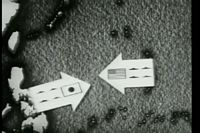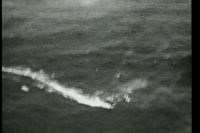
Battle for the Marianas
 |
 |
It starts out by talking about U.S. possessions in the Pacific before the war, including Guam.
 |
On islands under Japanese control, “the islanders worked hard for their Asiatic masters.”
 |
Summer, 1944, the struggle for the Marianas.
 |
Soldiers board ships for the Saipan invasion. This was Operation Forager.
 |
A U.S. scout plane taking off.
 |
Back view. It's being launched from a ship.
 |
Carrier planes take off for their strike.
 |
The planes attack an enemy airfield.
 |
The ships bombarded the island. Sometimes the guns became so hot they had to use water to cool them off.
 |
The fighting is fierce as usual.
 |
A land-based rocket launcher.
 |
By the end of the first few days, the troops have taken over an important Japanese airbase.
 |
By June 18th, the Marines had seized the southern white area.
 |
Again, the airstrip is quickly worked on to make it usable for U.S. planes. Planes from there were used in support of the attack on the northern part of the island.
 |
The Japanese also used tanks in the battle, losing 31 in one three-hour battle alone.
 |
The Battle of the Philippine Sea.
 |
U.S. planes attack the Japanese fleet.
 |
The Marianas Turkey Shoot.
A damaged U.S. plane landing on a carrier. It lands pretty well, but then it bursts into flame.
U.S. forces attack a 1500 foot mountain held by the Japanese.
Marines in another area are taking the capital city.
The civilians came out of caves and other areas they had fled to and were cared for by the U.S. troops.
July 7th, and the area under U.S. control has expanded considerably.
The results of a typical Banzai charge; lots of Japanese soldiers dead and nothing really gained for them. Over 2000 Japanese died in this one charge alone.
The U.S. appeals to the remaining Japanese troops to surrender.
“A few more enemy soldiers joined their ancestors.”
“Some of the natives chose suicide.”
On the southern tip of Saipan, U.S. artillery attacks Tinian, which was only three miles away.
Some prisoners were taken.
Guam is invaded. The battle took 21 days.
Still more airstrips are constructed.
Some of these airfields, though, would be used for launching the B-29 attacks on Japan.
Main Index
Japan main page
Japanese-American Internment Camps index page
Japan and World War II index page
|
|